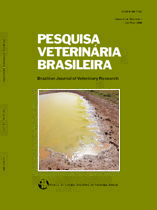 |
|
|
|
Year 2014 - Volume 34, Number 5
|

|
Clinical, histopathological and molecular aspects of the dermatosparaxis in White Dorper sheep, 34(5):443-448
|
ABSTRACT.- Andrade D.G.A., Pavan L.F., Amorim R.M., Chiacchio S.B., Laufer-Amorim R., Gonçalves R.C., Borges A.S. & Oliveira-Filho J.P. 2014. [Clinical, histopathological and molecular aspects of the dermatosparaxis in White Dorper sheep.] Aspectos clínicos, histopatológicos e moleculares da dermatosparaxia em ovinos White Dorper. Pesquisa Veterinária Brasileira 34(5):443-448. Departamento de Clínica Veterinária, Faculdade de Medicina Veterinária e Zootecnia, Universidade Estadual Paulista, Campus de Botucatu, Distrito de Rubião Júnior s/n, Botucatu, SP 18618-000, Brazil. E-mail: zefilho@fmvz.unesp.br
Dermatosparaxis in animals is an autosomal recessive disorder of the connective-tissue clinically characterized by skin fragility and hiperextensibility. The disease in White Dorper sheep is caused by mutation (c.421G>T) in the ADAM metalloproteinase with thrombospondin type 1 motif, 2 (ADAMTS2) gene. This study describes the dermatological, histological and the molecular findings of the dermatosparaxis in White Dorper sheep from a herd located in the center-west of São Paulo State. The herd consisted of one ram, four ewe and their lambs. In this herd two lambs had clinical signs consistent with dermatosparaxis. Histopathological evaluation of the affected skin of these two animals also revealed consistent findings with dermatosparaxis, characterized by dysplasia of the collagen, which were arranged in small and fragmented collagen bundles and with foci of degeneration of collagen. Prominent cutaneous appendages and severe hemorrhagic focus in dermis region associated with mild neutrophilic infiltrate in the deep dermis. PCR using DNA blood and specific primers to amplify the mutation region c.421G>T was optimized in order to perform molecular diagnosis of the disease. The direct sequencing of the PCR products proved that the two clinically affected animals had the mutation responsible for dermatosparaxis, previously described for this breed and allowed the definitive diagnosis of the disease. This is the first report of the dermatosparaxis in White Dorper sheep in Brazil and the methodology used to confirm the diagnosis could be used in future studies to assess the prevalence of this mutation in Brazil, allowing the adoption of measures to prevent the spread of this mutation in the Brazilian White Dorper herd. |
| |
|
|
| |
|
 |